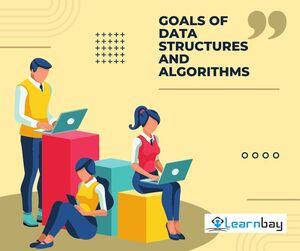Goals of Data structures and Algorithms
Corps
Basic Data Structures and Algorithms Overview
If the data is organized properly and saved on storage devices and in the computer's memory, it can be accessed rapidly for processing, which further lowers latency and gives the user swift service.
A data structure is an organisation of data in a computer's memory that enables the data to be promptly made available to the processor for necessary calculations, or in other words, a data structure is a strategy for organising data. One should think of a data structure as a logical idea that must take care of two fundamental issues. How will the data be saved, first, and then what operations will be made on it? Since a data structure is a plan for organising data, its functional specification should be unrelated to how it is actually used. ADT (Abstract Data Type), which is independent of implementation, is the term for the functional definition of a data structure. Developers are left in charge of selecting the technology that best fits the requirements of their projects. Check out the popular DSA course, to start mastering the essentials of data structures and algorithms for your tech career.
A structure that enables operations like push and pop is called a stack ADT, for instance. A linked list or an array, for instance, can be used to implement a stack.
Along with the emergence of data structures, data structures and algorithms are used in real-world problem-solving. An algorithm is a method for solving a problem step by step. Algorithms are used in programming through procedures, functions, and routines. In order to solve an issue, we need both an algorithm and an efficient algorithm. The algorithm's running time is one criterion for efficiency, and the memory it uses could be another.
When processing a data structure, there may be multiple methods accessible for the same problem, and we must select the optimal solution among those that are offered. Algorithm analysis is used to do this. The ideal algorithm is one that strikes a delicate balance between memory usage and processing time. The best, however, is uncommon, and we typically place more value on how long an algorithm takes than how much memory it uses. Additionally, run time analysis is more important than a memory because computers today have more memory than they did in the past and memory is getting cheaper. We will talk about algorithm analysis separately because it is a whole different subject.
Goals of Data Structure
Large amounts of data are organised and stored in data structures in computer memory. It makes sure that data can be used later on effectively. Logic or mathematics can be used to store data. Depending on the requirements of the organisation and levels of adaptability, it may change. Adaptation of the data models depends on two things:
- The structure was created to reflect how data related to actual items in the environment.
- Low level of complexity to promote robustness and reuse.
When a programme is created, the ideal outcome has particular conditions:
- It matters whether the solution is accurate.
- The solution's effectiveness.
- Additionally, efficient data structures are required.
- It must be more affordable, more space-efficient, and faster than other options.
By reducing space and temporal complexity, the correct data structure and algorithm can improve the advantages while decreasing the costs. It permits appropriate access to and data alteration. The elements' relationships with one another and their proper place in the problem-solving process are defined by the data structure.
Characteristics of Data structures
Both homogeneous and nonhomogeneous data structures are possible. The elements in a homogenous data structure all have the same data types. For instance, a collection
Non-homogeneous data structures may contain a variety of data kinds.
- It guarantees that data robustness is upheld.
- Data structure maximises the data's reusability and uses less memory during processing
- Time complexity is the time needed to complete each process in the data structure.
- Space complexity is the amount of space needed by each data structure-activity
- Data structure guarantees effectiveness and maintains the accuracy of the data recorded. You can gain an in-depth comprehension of these ideas by enrolling in an online data structures course.
Benefits of Data Structures
- A problem's efficiency is increased and the solution is optimised for minimal space and time complexity when the appropriate data structure is employed.
- Depending on the scope of the application, a particular data structure that has been built there may also be used elsewhere. This makes the data more reliable and reusable.
- Since it abstracts the data at many levels, the only point of interaction between the user and the data is the interface.
- The storing and processing of data in software are made simpler by data structures.
Utilization of common data structures
Array: In contiguous memory locations, an array stores elements of the same data type. Arrays come in both one and two dimensions. It is a linear, static data structure. In a system, actions like searching and sorting typically use arrays. An index value is associated with each element in an array.
Linked list: A linked list has nodes that store data and have memory tied to them. Data is kept in a contiguous memory area, therefore the address kept in the node connects it to the address where the data is kept after that.
Stack: A linear data structure called a stack permits insertion and deletion through its open end. Push and Pop are two terms used to describe insertion and deletion respectively.
Queue: The first in, first out (FIFO) rule is applied to yet another linear data structure. En queue dequeue arethe term used to describe insertion into queues and deletion from queues.
Graph: The non-linear data structure known as a graph has nodes and edges. It joins up other nodes in the network to create a graphical representation of the object. You can have a directed or undirected graph. Undirected graphs are bidirectional, while directed graphs have a single direction of connection.
Trees: The data structures used in trees are not linear. The data elements and it establish hierarchical relationships. The tree's root node serves as its starting point. There may be subtrees within a tree. The link between a parent and child is evident. Child nodes are those nodes that branch off from a specific node. There can only be one parent node, even though a parent node can have many children.
Last word
For scalability and reliability, data structures provide systematic data storage. Data manipulation and easy computation are made possible by a data structure that has been implemented correctly. Each background computer programme in software uses a data structure to increase efficiency with increasing space and time complexity. There are thousands of background programmes that run in software. The efficacy of the data and code depends on its accuracy. The fundamental building blocks for writing computer code are data structures and algorithms. Click here to learn about the data structures and algorithms course available online. Utilizing data structures and algorithms to their fullest potential during implementation, the problem-solving.









commentaires